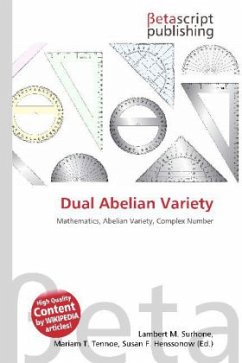
Dimension of an Algebraic Variety
Versandkostenfrei!
Versandfertig in 6-10 Tagen
23,99 €
inkl. MwSt.

PAYBACK Punkte
12 °P sammeln!
Please note that the content of this book primarily consists of articles available from Wikipedia or other free sources online. In mathematics, the dimension of an algebraic variety V in algebraic geometry is defined, informally speaking, as the number of independent rational functions that exist on V. For example, an algebraic curve has by definition dimension 1. That means that any two rational functions F and G on it must satisfy some polynomial relation P(F,G) = 0. This implies that F and G are constrained to take related values (up to some finite freedom of choice): they cannot be truly i...
Please note that the content of this book primarily consists of articles available from Wikipedia or other free sources online. In mathematics, the dimension of an algebraic variety V in algebraic geometry is defined, informally speaking, as the number of independent rational functions that exist on V. For example, an algebraic curve has by definition dimension 1. That means that any two rational functions F and G on it must satisfy some polynomial relation P(F,G) = 0. This implies that F and G are constrained to take related values (up to some finite freedom of choice): they cannot be truly independent. For an algebraic variety V over a field K, the dimension of V is the transcendence degree over K of the function field K(V) of all rational functions on V, with values in K. For the function field even to be defined, V here must be an irreducible algebraic set; in which case the function field (for an affine variety) is just the field of fractions of the coordinate ring of V. Using polynomial equations, it is easy to define sets that have ''mixed dimension'': a union of a curve and a plane in space, for example. These fail to be irreducible.












